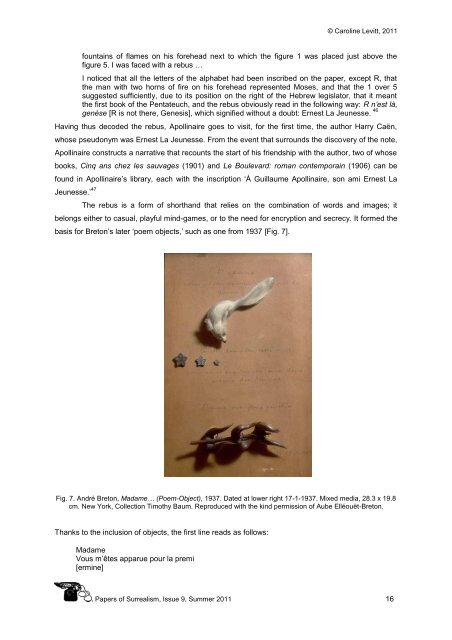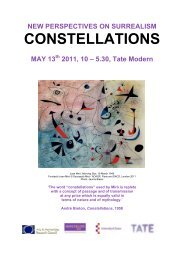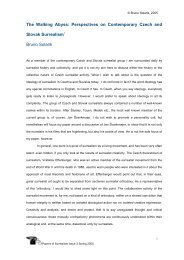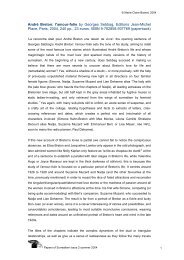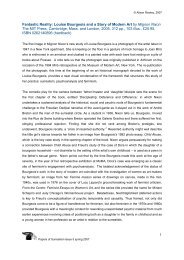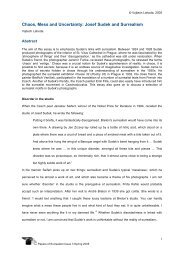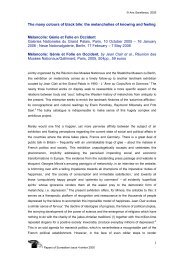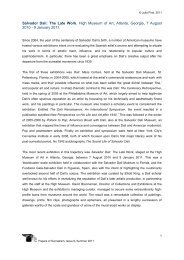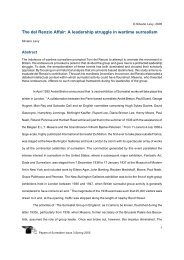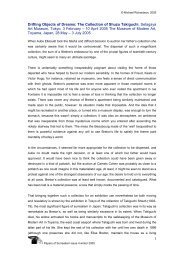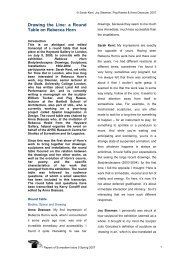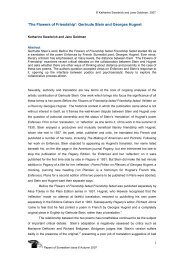From the Walls of Factories to the Poetry of the Street: Inscriptions ...
From the Walls of Factories to the Poetry of the Street: Inscriptions ...
From the Walls of Factories to the Poetry of the Street: Inscriptions ...
You also want an ePaper? Increase the reach of your titles
YUMPU automatically turns print PDFs into web optimized ePapers that Google loves.
© Caroline Levitt, 2011<br />
fountains <strong>of</strong> flames on his forehead next <strong>to</strong> which <strong>the</strong> figure 1 was placed just above <strong>the</strong><br />
figure 5. I was faced with a rebus …<br />
I noticed that all <strong>the</strong> letters <strong>of</strong> <strong>the</strong> alphabet had been inscribed on <strong>the</strong> paper, except R, that<br />
<strong>the</strong> man with two horns <strong>of</strong> fire on his forehead represented Moses, and that <strong>the</strong> 1 over 5<br />
suggested sufficiently, due <strong>to</strong> its position on <strong>the</strong> right <strong>of</strong> <strong>the</strong> Hebrew legisla<strong>to</strong>r, that it meant<br />
<strong>the</strong> first book <strong>of</strong> <strong>the</strong> Pentateuch, and <strong>the</strong> rebus obviously read in <strong>the</strong> following way: R n’est là,<br />
genèse [R is not <strong>the</strong>re, Genesis], which signified without a doubt: Ernest La Jeunesse. 46<br />
Having thus decoded <strong>the</strong> rebus, Apollinaire goes <strong>to</strong> visit, for <strong>the</strong> first time, <strong>the</strong> author Harry Caën,<br />
whose pseudonym was Ernest La Jeunesse. <strong>From</strong> <strong>the</strong> event that surrounds <strong>the</strong> discovery <strong>of</strong> <strong>the</strong> note,<br />
Apollinaire constructs a narrative that recounts <strong>the</strong> start <strong>of</strong> his friendship with <strong>the</strong> author, two <strong>of</strong> whose<br />
books, Cinq ans chez les sauvages (1901) and Le Boulevard: roman contemporain (1906) can be<br />
found in Apollinaire‟s library, each with <strong>the</strong> inscription „À Guillaume Apollinaire, son ami Ernest La<br />
Jeunesse.‟ 47<br />
The rebus is a form <strong>of</strong> shorthand that relies on <strong>the</strong> combination <strong>of</strong> words and images; it<br />
belongs ei<strong>the</strong>r <strong>to</strong> casual, playful mind-games, or <strong>to</strong> <strong>the</strong> need for encryption and secrecy. It formed <strong>the</strong><br />
basis for Bre<strong>to</strong>n‟s later „poem objects,‟ such as one from 1937 [Fig. 7].<br />
Fig. 7. André Bre<strong>to</strong>n, Madame… (Poem-Object), 1937. Dated at lower right 17-1-1937. Mixed media, 28.3 x 19.8<br />
cm. New York, Collection Timothy Baum. Reproduced with <strong>the</strong> kind permission <strong>of</strong> Aube Elléouët-Bre<strong>to</strong>n.<br />
Thanks <strong>to</strong> <strong>the</strong> inclusion <strong>of</strong> objects, <strong>the</strong> first line reads as follows:<br />
Madame<br />
Vous m‟êtes apparue pour la premi<br />
[ermine]<br />
Papers <strong>of</strong> Surrealism, Issue 9, Summer 2011 16


